On these pages we are looking at set related categories. The category theory of a set is discussed on the page here. We then go on to look at sets with some additional structure. On this page we start to look at sets with an order relation added.
First lets look at this structure from a set theoretic point of view. That is we look inside the set, at its elements, rather than looking at its external category theoretic properties.
Strictly Ordered
First lets assume the relation is total and strictly ordered. That is for every pair of elements 'a' and 'b' then either: a<b or a>b.
Examples of strictly ordered sets are:
strictly ordered sets are: transitive: if a<b and b<c then a<c But they don't have the following properties:
|
 |
If S is a set, then the order relation on S can be considered as a subset of S×S or a map S×S-> π where π is the truth object (in this case Boolean).
More about order relation on page here
So how is the category defined?
ObjectsThe objects are {}, {0}, {0,1}, {0,1,2}, {0,1,2,3} and so on. Not necessarily labeled but it helps understanding to label with numerals. As with general sets the objects are a 0 element set, a 1 element set, a 2 element set and so on but here
|
 |
ArrowsArrows are order preseving functors (or cofunctors - see below) between these objects. That is: if a<b then F a < F b |
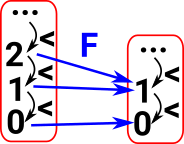 |
Weakly Ordered
Here the relation is total and strictly ordered. That is for every pair of elements 'a' and 'b' then then it could be that: a<=b or a>=b or both a=b.
Weakly ordered sets are:
But they don't have the following properties:
Although for some cases its possible that
|
 |
If S is a set, then the order relation on S can be considered as a subset of S×S or a map S×S-> π where π is the truth object (in this case Boolean).
More about order relation on page here
So how is the category defined?
ObjectsNot necessarily labeled but it helps understanding to label with numerals. As with general sets the objects are a 0 element set, a 1 element set, a 2 element set and so on but here the objects are {}, {0}, {0,1}, {0,1,2}, {0,1,2,3} and so on. Also objects where the elements are repeated such as {0,0}, {0,0,1}, {0,1,1} and so on. These are known as degenerate sets. |
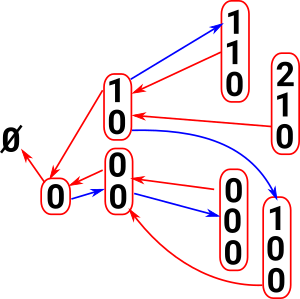 |
ArrowsThe arrows preserve this weak order. That is: if a<=b then F a <= F b |
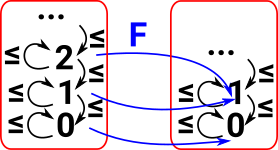 |
Decomposing Arrows
Order preserving arrows can be decomposed into a sequence of arrows that insert or merge single elements one at a time.
We will call these elemental mappings di and si di is an injective mapping which goes from a set of size n to a set of size n+1 si is a surjective mapping which goes from a set of size n to a set of size n-1 |
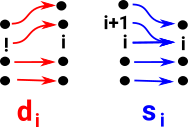
|
So we can construct any order preserving mapping from a sequence of di and si.
Decomposing Arrows in Setop
Setop is a category with the same objects as set but where the arrows are reversed as explained on the page here. In this case order preserving arrows can again be decomposed into a sequence of arrows although , in this case, we don't have the concept of injective and surjective mappings (or we have the reverse of these concepts).
So the elemental mappings di and si become: face map: di is a mapping (reverse of injective) which removes element 'i' and goes from a set of size n to a set of size n-1. degeneracy map: si is a mapping (reverse of surjective) which duplicates an element and goes from a set of size n to a set of size n+1 |
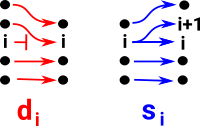 |
Subobjects
We can create any subobject using a sequence of face maps.
Equalities
Degeneracy maps create equal elements.
Identities
Note: when combining maps below the map on the right is done first. For example, di dj means di after dj (do dj then do di).
| Identity | diagram |
|---|---|
| di dj = dj-1 di if i < j | 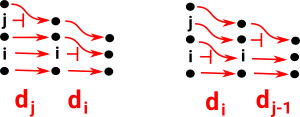 |
| di sj = s j-1 di if i < j | 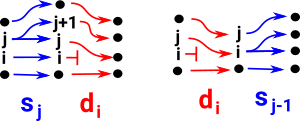 |
| dj sj = id = dj+1 sj | 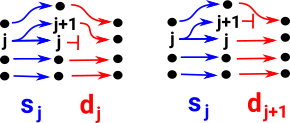 |
| di sj = sj di-1 if i > j+1 | 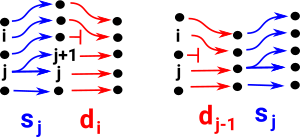 |
| si sj = s j+1 s i if i ≤ j | 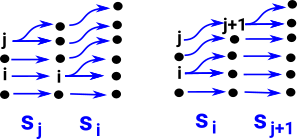 |
Simplicial Sets
See page here about simplicial sets.
